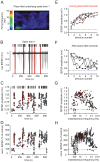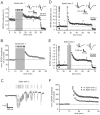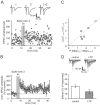Natural spike trains trigger short- and long-lasting dynamics at hippocampal mossy fiber synapses in rodents
- PMID: 20376354
- PMCID: PMC2848597
- DOI: 10.1371/journal.pone.0009961
Natural spike trains trigger short- and long-lasting dynamics at hippocampal mossy fiber synapses in rodents
Abstract
Background: Synapses exhibit strikingly different forms of plasticity over a wide range of time scales, from milliseconds to hours. Studies on synaptic plasticity typically use constant-frequency stimulation to activate synapses, whereas in vivo activity of neurons is irregular.
Methodology/principal findings: Using extracellular and whole-cell electrophysiological recordings, we have here studied the synaptic responses at hippocampal mossy fiber synapses in vitro to stimulus patterns obtained from in vivo recordings of place cell firing of dentate gyrus granule cells in behaving rodents. We find that synaptic strength is strongly modulated on short- and long-lasting time scales during the presentation of the natural stimulus trains.
Conclusions/significance: We conclude that dynamic short- and long-term synaptic plasticity at the hippocampal mossy fiber synapse plays a prominent role in normal synaptic function.
Conflict of interest statement
Figures






Similar articles
-
Short-Term Plasticity at Hippocampal Mossy Fiber Synapses Is Induced by Natural Activity Patterns and Associated with Vesicle Pool Engram Formation.Neuron. 2020 Aug 5;107(3):509-521.e7. doi: 10.1016/j.neuron.2020.05.013. Epub 2020 Jun 2. Neuron. 2020. PMID: 32492366 Free PMC article.
-
Long- and short-term plasticity at mossy fiber synapses on mossy cells in the rat dentate gyrus.Hippocampus. 2005;15(6):691-6. doi: 10.1002/hipo.20096. Hippocampus. 2005. PMID: 15986406
-
Recurrent mossy fiber pathway in rat dentate gyrus: synaptic currents evoked in presence and absence of seizure-induced growth.J Neurophysiol. 1999 Apr;81(4):1645-60. doi: 10.1152/jn.1999.81.4.1645. J Neurophysiol. 1999. PMID: 10200201
-
Synaptic plasticity at hippocampal mossy fibre synapses.Nat Rev Neurosci. 2005 Nov;6(11):863-76. doi: 10.1038/nrn1786. Nat Rev Neurosci. 2005. PMID: 16261180 Review.
-
Targeting the hippocampal mossy fiber synapse for the treatment of psychiatric disorders.Mol Neurobiol. 2009 Feb;39(1):24-36. doi: 10.1007/s12035-008-8049-5. Epub 2009 Jan 8. Mol Neurobiol. 2009. PMID: 19130314 Review.
Cited by
-
Presynaptic LTP and LTD of excitatory and inhibitory synapses.Cold Spring Harb Perspect Biol. 2012 Feb 1;4(2):a005728. doi: 10.1101/cshperspect.a005728. Cold Spring Harb Perspect Biol. 2012. PMID: 22147943 Free PMC article. Review.
-
Short-Term Plasticity at Hippocampal Mossy Fiber Synapses Is Induced by Natural Activity Patterns and Associated with Vesicle Pool Engram Formation.Neuron. 2020 Aug 5;107(3):509-521.e7. doi: 10.1016/j.neuron.2020.05.013. Epub 2020 Jun 2. Neuron. 2020. PMID: 32492366 Free PMC article.
-
Intrinsic and Synaptic Contributions to Repetitive Spiking in Dentate Granule Cells.J Neurosci. 2024 May 1;44(18):e0716232024. doi: 10.1523/JNEUROSCI.0716-23.2024. J Neurosci. 2024. PMID: 38503495 Free PMC article.
-
Information processing and synaptic plasticity at hippocampal mossy fiber terminals.Front Cell Neurosci. 2014 Feb 4;8:28. doi: 10.3389/fncel.2014.00028. eCollection 2014. Front Cell Neurosci. 2014. PMID: 24550783 Free PMC article. Review.
-
Single Bursts of Individual Granule Cells Functionally Rearrange Feedforward Inhibition.J Neurosci. 2018 Feb 14;38(7):1711-1724. doi: 10.1523/JNEUROSCI.1595-17.2018. Epub 2018 Jan 15. J Neurosci. 2018. PMID: 29335356 Free PMC article.
References
-
- Malenka RC, Nicoll RA. Long-term potentiation–a decade of progress? Science. 1999;285:1870–1874. - PubMed
-
- Zucker RS, Regehr WG. Short-term synaptic plasticity. Annu Rev Physiol. 2002;64:355–405. - PubMed
-
- O'Keefe J. A review of the hippocampal place cells. Prog Neurobiol. 1979;13:419–439. - PubMed
-
- O'Keefe J, Dostrovsky J. The hippocampus as a spatial map. Preliminary evidence from unit activity in the freely-moving rat. Brain Res. 1971;34:171–175. - PubMed
-
- Wilson MA, McNaughton BL. Dynamics of the hippocampal ensemble code for space. Science. 1993;261:1055–1058. - PubMed
Publication types
MeSH terms
Grants and funding
LinkOut - more resources
Full Text Sources

